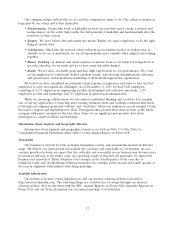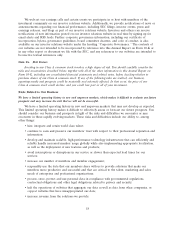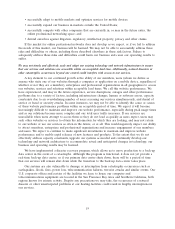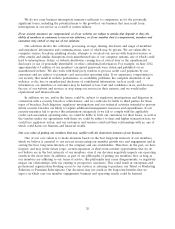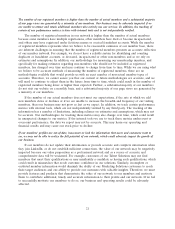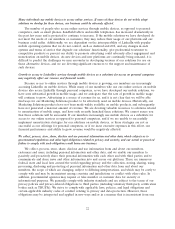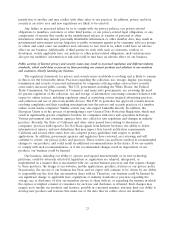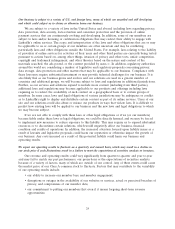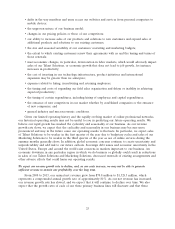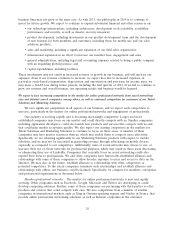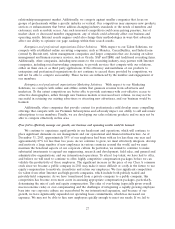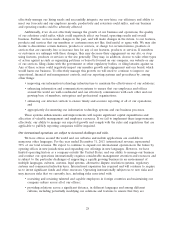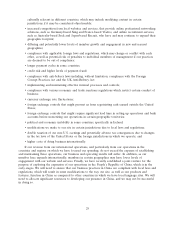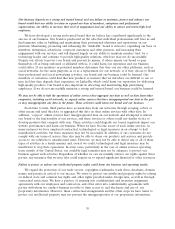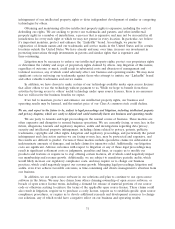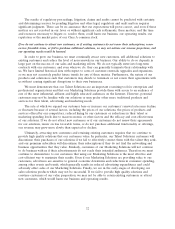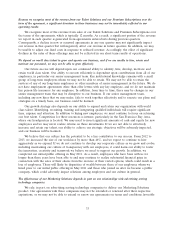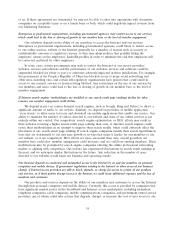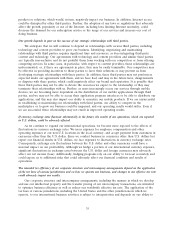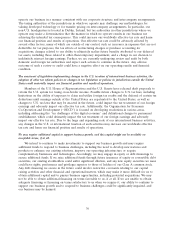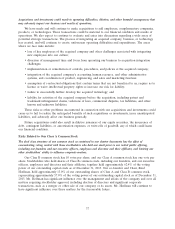LinkedIn 2013 Annual Report Download - page 29
Download and view the complete annual report
Please find page 29 of the 2013 LinkedIn annual report below. You can navigate through the pages in the report by either clicking on the pages listed below, or by using the keyword search tool below to find specific information within the annual report.relationship management market. Additionally, we compete against smaller companies that focus on
groups of professionals within a specific industry or vertical. Our competitors may announce new products,
services or enhancements that better address changing industry standards or the needs of members and
customers, such as mobile access. Any such increased competition could cause pricing pressure, loss of
market share or decreased member engagement, any of which could adversely affect our business and
operating results. Internet search engines could also change their methodologies in ways that adversely
affect our ability to optimize our page rankings within their search results.
Enterprises and professional organizations-Talent Solutions. With respect to our Talent Solutions, we
compete with established online recruiting companies, such as Monster, CareerBuilder, and Indeed.com
(owned by Recruit.net), talent management companies and larger companies that are focusing on talent
management and human resource services, such as Oracle, SAP and IBM, and traditional recruiting firms.
Additionally, other companies, including newcomers to the recruiting industry, may partner with Internet
companies, including social networking companies, to provide services that compete with our solutions,
either on their own or as third party applications. If the efficiency and usefulness of our products to
enterprises and professional organizations do not continue to exceed those provided by competitors, we
will not be able to compete successfully. These factors are influenced by the number and engagement of
our members.
Enterprises and professional organizations-Marketing Solutions. With respect to our Marketing
Solutions, we compete with online and offline outlets that generate revenue from advertisers and
marketers. To the extent competitors are better able to provide customers with cost-effective access to
attractive demographics, either through new business models or increased user volume, we may not be
successful in retaining our existing advertisers or attracting new advertisers, and our business would be
harmed.
Additionally, other companies that provide content for professionals could develop more compelling
offerings that compete with our Premium Subscriptions and adversely impact our ability to sell and renew
subscriptions to our members. Finally, we are developing our sales solutions products and we may not be
able to compete effectively in this area.
If we fail to effectively manage our growth, our business and operating results could be harmed.
We continue to experience rapid growth in our headcount and operations, which will continue to
place significant demands on our management and our operational and financial infrastructure. As of
December 31, 2013, approximately 38% of our employees had been with us for less than one year and
approximately 87% for less than two years. As we continue to grow, we must effectively integrate, develop
and motivate a large number of new employees in various countries around the world, and we must
maintain the beneficial aspects of our corporate culture. In particular, we intend to continue to make
substantial investments to expand our engineering, research and development, field sales, and general and
administrative organizations, and our international operations. To attract top talent, we have had to offer,
and believe we will need to continue to offer, highly competitive compensation packages before we can
validate the productivity of those employees. The significant increase in the price of our Class A common
stock since we became a public company in 2011 may make it more difficult or costly in the future to use
equity compensation to motivate, incentivize and retain our employees. We face significant competition
for talent from other Internet and high-growth companies, which include both publicly traded and
privately-held companies. As we have transitioned from a private company to a public company, this
competition has become even more acute in assessing appropriate compensation packages, particularly,
determining the mix of cash and equity compensation. The risks of over-hiring (especially given overall
macroeconomic risks) or over-compensating and the challenges of integrating a rapidly growing employee
base into our corporate culture are exacerbated by our international expansion, and because of our
growth, we have significantly expanded our operating lease commitments, which has increased our
expenses. We may not be able to hire new employees quickly enough to meet our needs. If we fail to
27


